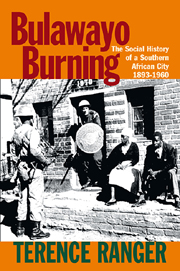Book contents
- Frontmatter
- Contents
- List of Illustrations
- Introduction
- Prelude: Bulawayo, 1893–1930
- 1 The Landscapes of Bulawayo
- 2 The First Fires: December 1929
- 3 City versus State 1930–1946
- 4 Mr Black Bulawayo 1930–1948
- 5 The Feminization of Black Bulawayo 1948–1960
- 6 Black Bulawayo Transformed
- 7 Black Bulawayo Burns 1960
- Postlude: Bulawayo after 1960
- Selected Bibliography
- Index
Prelude: Bulawayo, 1893–1930
Published online by Cambridge University Press: 05 April 2013
- Frontmatter
- Contents
- List of Illustrations
- Introduction
- Prelude: Bulawayo, 1893–1930
- 1 The Landscapes of Bulawayo
- 2 The First Fires: December 1929
- 3 City versus State 1930–1946
- 4 Mr Black Bulawayo 1930–1948
- 5 The Feminization of Black Bulawayo 1948–1960
- 6 Black Bulawayo Transformed
- 7 Black Bulawayo Burns 1960
- Postlude: Bulawayo after 1960
- Selected Bibliography
- Index
Summary
Royal Bulawayo Burns
There have been three Bulawayos, two established by Lobengula and a third established by Cecil Rhodes. Lobengula's Bulawayos both ended in flames. The actual and metaphorical fires in colonial Bulawayo form the subject of this book.
Lobengula's first Bulawayo was burnt as part of royal custom. Whenever an Ndebele King moved his town the previous site was burnt to the ground. Royal towns were ritually fortified at various places – around the King's house, at the palisade, etc. The medicines could not be allowed to fall into the hands of witches and so everything was fired when the King left. The site of KoBulawayo (Old Bulawayo), which today is being restored and rebuilt, was abandoned by King Lobengula in 1881 and was set on fire by Induna Magwegwe Fuyane just after full moon on 15 September. As the Jesuit missionaries reported:
Makwekwe set about burning the King's palace, the queens’ huts, all the buildings in the royal kraaal, sheds, coach-houses, stables and even old King Mosilikatsi's wagons.
The burning of New Bulawayo twelve years later at the climax of the 1893 Matabele War was less ceremonial and more spectacular. Lobengula left the town as the white column fought its way from Fort Victoria. Few whites had ever approached Bulawayo from the east and the American Scout, F.R. Burnham, was sent ahead to locate the royal town. Burnham was hoping to take his bearings from Ntabas Induna, which turned out to be ‘a miserable little molehill’, but eventually found a spot from which to view Bulawayo.
- Type
- Chapter
- Information
- Bulawayo BurningThe Social History of a Southern African City, 1893–1960, pp. 14 - 52Publisher: Boydell & BrewerPrint publication year: 2010



